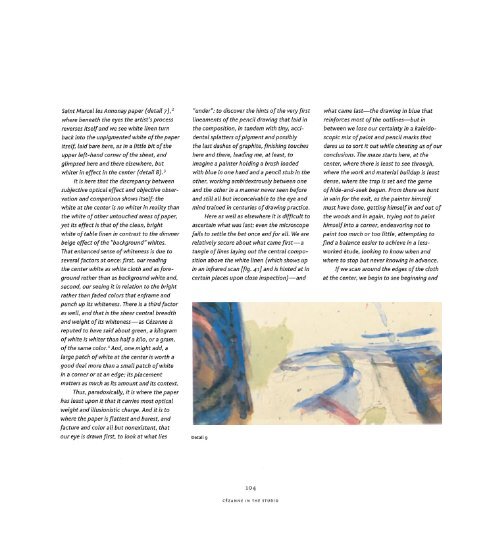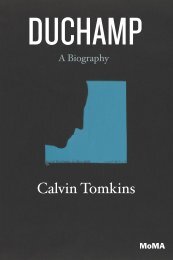Still Life in Watercolors
qbj8dgc
qbj8dgc
- No tags were found...
You also want an ePaper? Increase the reach of your titles
YUMPU automatically turns print PDFs into web optimized ePapers that Google loves.
Sa<strong>in</strong>t Marcel les Annonay paper (detail j), 2<br />
where beneath the eyes the artist's process<br />
reverses itself and we see white l<strong>in</strong>en turn<br />
back <strong>in</strong>to the unpigmented white of the paper<br />
itself", laid bare here, as <strong>in</strong> a little bit of the<br />
upper left-hand corner of the sheet, and<br />
glimpsed here and there elsewhere, but<br />
whiter <strong>in</strong> effect <strong>in</strong> the center (detail 8). 3<br />
It is here that the discrepancy between<br />
subjective optical effect and objective observation<br />
and comparison shows itself: the<br />
white at the center is no whiter <strong>in</strong> reality than<br />
the white of other untouched areas of paper,<br />
yet its effect is that of the clean, bright<br />
white of table l<strong>in</strong>en <strong>in</strong> contrast to the dimmer<br />
beige effect of the "background" whites.<br />
That enhanced sense of whiteness is due to<br />
several factors at once: first, our read<strong>in</strong>g<br />
the center white as white cloth and as foreground<br />
rather than as background white and,<br />
second, our see<strong>in</strong>g it <strong>in</strong> relation to the bright<br />
rather than faded colors that enframe and<br />
punch up its whiteness. There is a third factor<br />
as well, and that is the sheer central breadth<br />
and weight of its whiteness—as Cezanne is<br />
reputed to have said about green, a kilogram<br />
of white is whiter than half a kilo, or a gram,<br />
of the same color. 4 And, one might add, a<br />
large patch of white at the center is worth a<br />
good deal more than a small patch of white<br />
<strong>in</strong> a corner or at an edge; its placement<br />
matters as much as its amount and its context<br />
Thus, paradoxically, it is where the paper<br />
has least upon it that it carries most optical<br />
weight and illusionistic charge. And it is to<br />
where the paper is flattest and barest, and<br />
facture and color all but nonexistent, that<br />
our eye is drawn first, to look at what lies<br />
"under": to discover the h<strong>in</strong>ts of the very first<br />
l<strong>in</strong>eaments of the pencil draw<strong>in</strong>g that laid <strong>in</strong><br />
the composition, <strong>in</strong> tandem with t<strong>in</strong>y, accidental<br />
splatters of pigment and possibly<br />
the last dashes of graphite, f<strong>in</strong>ish<strong>in</strong>g touches<br />
here and there, lead<strong>in</strong>g me, at least, to<br />
imag<strong>in</strong>e a pa<strong>in</strong>ter hold<strong>in</strong>g a brush loaded<br />
with blue <strong>in</strong> one hand and a pencil stub <strong>in</strong> the<br />
other, work<strong>in</strong>g ambidextrously between one<br />
and the other <strong>in</strong> a manner never seen before<br />
and still all but <strong>in</strong>conceivable to the eye and<br />
m<strong>in</strong>d tra<strong>in</strong>ed <strong>in</strong> centuries of draw<strong>in</strong>g practice.<br />
Here as well as elsewhere it is difficult to<br />
ascerta<strong>in</strong> what was last; even the microscope<br />
fails to settle the bet once and for all. We are<br />
relatively secure about what came first—a<br />
tangle of l<strong>in</strong>es lay<strong>in</strong>g out the central composition<br />
above the white l<strong>in</strong>en (which shows up<br />
<strong>in</strong> an <strong>in</strong>frared scan [fig. 41] and is h<strong>in</strong>ted at <strong>in</strong><br />
certa<strong>in</strong> places upon close <strong>in</strong>spection)—and<br />
Detail 9<br />
what came last—the draw<strong>in</strong>g <strong>in</strong> blue that<br />
re<strong>in</strong>forces most of the outl<strong>in</strong>es—but <strong>in</strong><br />
between we lose our certa<strong>in</strong>ty <strong>in</strong> a kaleidoscopic<br />
mix of pa<strong>in</strong>t and pencil marks that<br />
dares us to sort it out while cheat<strong>in</strong>g us of our<br />
conclusions. The maze starts here, at the<br />
center, where there is least to see through,<br />
where the work and material buildup is least<br />
dense, where the trap is set and the game<br />
of hide-and-seek begun. From there we hunt<br />
<strong>in</strong> va<strong>in</strong> for the exit, as the pa<strong>in</strong>ter himself<br />
must have done, gett<strong>in</strong>g himself <strong>in</strong> and out of<br />
the woods and <strong>in</strong> aga<strong>in</strong>, try<strong>in</strong>g not to pa<strong>in</strong>t<br />
himself <strong>in</strong>to a corner, endeavor<strong>in</strong>g not to<br />
pa<strong>in</strong>t too much or too little, attempt<strong>in</strong>g to<br />
f<strong>in</strong>d a balance easier to achieve <strong>in</strong> a lessworked<br />
etude, look<strong>in</strong>g to know when and<br />
where to stop but never know<strong>in</strong>g <strong>in</strong> advance.<br />
If we scan around the edges of the cloth<br />
at the center, we beg<strong>in</strong> to see beg<strong>in</strong>n<strong>in</strong>g and<br />
104<br />
CEZANNE IN THE STUDIO




